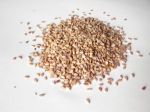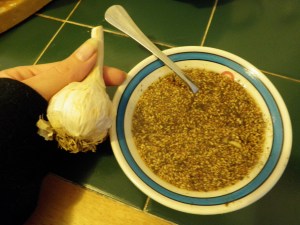
Oven fried chicken nuggets stay moist thanks to a coating of nut butter, and crunchy courtesy of panko crumbs. Early-season broccoli rabe is my veggie side, and Trader Joe's Mango Ginger Chutney serves as the dipping sauce du jour.
I love chicken nuggets. I know, really sophisticated of me? Ha!
Edited to Add: I was born and (mostly) grew up in Texas, where fried chicken was on the weekly menu rotation, at least in my earliest years. I’ve always loved it. Just the smell of it makes me nostalgic. But I can’t always eat it, for obvious reasons. These flavorful nuggets satisfy the crunchy, chicken-y craving, and aren’t as messy and hot as frying up a batch of chicken. Plus, my fried chicken never seems to taste quite as good as my mom’s.
Luckily, I’ve figured out how to give chicken nugget morsels a healthy, grown-up, and tasty upgrade.
The key ingredients? Nut butter plus panko bread crumbs (that stuff that makes tempura so crunchy and awesome at your favorite Japanese spot. Panko bread crumbs have become increasingly common in regular grocery stores in recent years. Progresso brand makes them, as does Roland. Roland is the brand I used in this recipe. I paid about $1.25 on sale for my 7 ounce bag, which will last awhile).
Coating chicken chunks with the nut butter of your choice is a great way to get crunchy panko crumbs to stick, and stick well, to the chicken pieces. Then just pop them in the oven for 15-20 minutes, and you have an irresistible nugget delight. The nut butter gives them another boost of flavor, and keeps the breast meat, which often tends to dry out, nice and juicy.
No panko crumbs? Try regular breadcrumbs from the store. Gluten free needed? Then coat the nuggets in nut butter, followed by a dusting of the ground nuts of your choice.
You can use the nut butter of your choice. I’ve tried this with almond butter, peanut butter, and sunflower seed butter. All work equally well, as does pistachio nut butter, which I made a batch of recently. Here’s the recipe link to Pistachio Honey Nut Butter:

Pistachio nut butter. Easy to make at home and a worthwhile option to coat your chicken nuggets in before dredging them in panko bread crumb awesomeness.
Bonus Tip: Prep extra nuggets and freeze them in a single layer, covered well. When it’s time to eat, just remove them from the freezer and bake them according to the directions below. No thawing necessary.
Baked Nut Butter Chicken Nuggets
Ingredients to make 2-4 servings (2 as entree, 4 as an appetizer):
- 1 pound of chicken breast, cut into chunks
- Seasoning blend of your choice
- Salt (ONLY if seasoning blend is unsalted)
- 1/2 cup nut butter of choice, more if necessary
- 1/2 cup panko bread crumbs (or alternatively,bread crumbs from a can, or ground nuts)
- Splash of water (might not need)
1. Preheat oven to 450 F.
2. Season the chicken with the seasoning blend, adding salt if necessary.
3. Spoon nut butter into a mixing bowl. Mix well. If it seems a bit dry, put in a tiny bit of water to loosen it up (it should be a texture that is slightly thinner than honey).
4. Place chicken chunks in nut butter and toss to coat, using your hands or a spoon to coat all sides.
5. Throw panko crumbs on top of chicken and mix well. If necessary, press crumbs into the chicken so they adhere. Make sure all sides of the chicken are coated with crumbs. Shake off excess crumbs.
6. On a baking sheet, in a single layer, bake the nuggets for 15 to 20 minutes.You don’t even need to turn them!
7. Serve with the side/s and or dipping sauce of your choice.


























